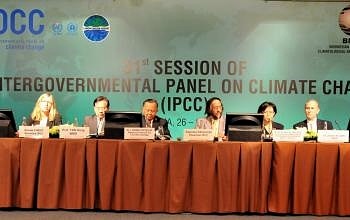Why the climate models of global warming are wrong
Steve Goreham

Climate science is in turmoil. Contrary to predictions by the world’s leading climate models and despite rising levels of atmospheric carbon dioxide, global surface temperatures have been flat for 16 years. How can the climate models be wrong?
Last October, the Daily Mail (London) announced that temperature data from the United Kingdom’s Meteorological Office showed no global warming for 16 years. In December, an advance chart from the upcoming Fifth Assessment Report of the Intergovernmental Panel on Climate Change showed a divergence between model projections and actual global temperatures. In January of this year, the Met Office revised its forecast of temperatures down to almost no increase over the next five years.
Media publications that have been staunch supporters of the theory of man-made climate change have noted the model failure. In March, The Economist stated, “The climate may be heating up in response to greenhouse gases less than was once thought.” The New York Times noted in June that the temperature slowdown “is a bit of a mystery to climate scientists.”
All major climate models have overestimated the effects of man-made warming. Analysis by Dr. Roy Spencer and Dr. John Christy shows that 44 of the world’s leading climate models projected an average temperature rise of about 0.5 degrees C during the last 16 years when measured temperatures were flat. The analysis was recently updated to include 73 of the leading climate models. Not a single model made an accurate forecast.
In any reasonable scenario, carbon dioxide can’t cause catastrophic global warming by itself. This is because the absorption of infrared radiation by CO2 is non-linear. The first 20 parts per million of CO2 in our atmosphere account for about one-half of the greenhouse warming from CO2. Adding more carbon dioxide has a diminishing warming effect. Doubling atmospheric CO2 from 280 ppm to 560 ppm, whether from natural or man-made causes, would by itself increase Earth’s surface temperature by only about 1.2 degrees C.
So how do the climate models reach their alarming conclusions? They assume that positive feedback from water vapor will cause additional warming. The argument is that, since warmer air can hold more moisture, water vapor will increase in the atmosphere as Earth warms. Since water vapor is a greenhouse gas, additional water vapor will add additional warming to that caused by CO2.
The assumption of positive feedback from water vapor has been integral to the climate models since the 1960s, when Syukuro Manabe developed one of the first models. As part of his model, he assumed that global relative humidity remained constant as the atmosphere heated up. This meant that the atmosphere would hold increasing amounts of water vapor, adding additional greenhouse heating to that of carbon dioxide.
But satellite data shows atmospheric water vapor as relatively constant in the last 30 years. And peer-reviewed papers by Lindzen and Choi (2011)(.pdf) and Spencer and Braswell (2010)(.pdf) show that climate system feedbacks are likely to be low or even negative. Rather than adding to the warming, water vapor and clouds may even act to reduce warming from rising atmospheric CO2.
It appears that the models have relied on a “flea wagging the dog” assumption. Forces driving Earth’s water cycle, which includes weather and the oceans, are many orders of magnitude more powerful than the ebb and flow of carbon dioxide into our atmosphere. A large hurricane releases heat energy at a rate of one exploding 10-megaton nuclear bomb every 20 minutes. The idea that the atmospheric level of CO2, a trace gas, is controlling weather and the water cycle is improbable. The idea that mankind’s relatively tiny CO2 emissions impact the water cycle is preposterous.
___________________________________________________________________________________
Steve Goreham, a policy advisor to The Heartland Institute, is a speaker, author, and researcher on environmental issues as well as an engineer and business executive. He is a frequently invited guest on radio and television as well as a free-lance writer. He is the Executive Director of the Climate Science Coalition of America (CSCA), a non-political association of scientists, engineers, and citizens dedicated to informing Americans about the realities of climate science and energy economics. CSCA is the US affiliate of the International Climate Science Coalition. Steve is the author of two books on climate change. His first book is Climatism! Science, Common Sense, and the 21st Century’s Hottest Topic, a complete, in-depth discussion of the science, politics, and energy policy implications of the man-made global warming debate. The Mad, Mad, Mad, World of Climatism is Steve’s second book on climate change, was published in 2012. A special edition of the book (with endnotes and bibliography moved to Steve’s Web site (climatism.net) was prepared for release by The Heartland Institute in 2013, and more than 100,000 copies are now in circulation. (Full bio.)
___________________________________________________________________________________
Article published here: Washington Times / Heartland Institute
URL: http://www.a-w-i-p.com/index.php/2013/10/25/why-the-climate-models-of
























